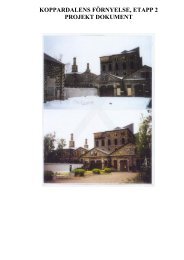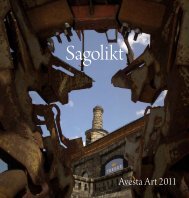Guide till Verket
Guide till Verket
Guide till Verket
Create successful ePaper yourself
Turn your PDF publications into a flip-book with our unique Google optimized e-Paper software.
| Galtsängar<br />
Det flytande tackjärnet tappades i<br />
galtsängar. Här ses några unika<br />
galtar i original med de spegelvända<br />
initialerna A.J & C – Axel<br />
Johnson och Company.<br />
Grosshandlaren, skeppsredaren<br />
och generalkonsuln Axel Johnson<br />
(1844-1910) blev 1905 huvudägare <strong>till</strong><br />
järnverket. Under större delen av 1900-talet<br />
hade familjen Johnson en betydande ledarroll<br />
och utvecklade järnverket, som med tiden kom<br />
att satsa på rostfritt stål.<br />
| Periskopet<br />
I periskopet kan vi<br />
uppleva arbetet hos<br />
uppsättaren uppe på<br />
masugnskransen 17<br />
meter upp.<br />
När den kalla<br />
malmen, kolen och<br />
kalken släpptes ner i<br />
den heta masugnen<br />
reste sig en pelare av<br />
rök och eldgnistor<br />
högt i skyn så att det<br />
syntes som ett skådespel<br />
över hela bygden.<br />
Det var viktigt att<br />
blandningen var den<br />
rätta för att smältan<br />
skulle bli rätt. En uppsättning<br />
kunde innehålla<br />
ungefär 420 kg<br />
malm, 15 hektoliter<br />
kol och 95 kg kalk.<br />
| Pig Beds<br />
The molten iron was run into pig<br />
beds. Here we can see unique pigs<br />
with their mirror-image initials A.J<br />
& C – Axel Johnson & Company.<br />
Merchant, ship owner and consul<br />
general, Axel Johnson (1844-1910)<br />
became the main owner of the ironworks<br />
in 1905. For the greater part<br />
of the 20th century, the Johnson<br />
family played a leading role and<br />
developed the ironworks, which<br />
eventually became a major producer<br />
of stainless steel.<br />
| The Periscope<br />
Through the periscope you can<br />
experience the work of the charger<br />
17 metres up on the charging platform.<br />
When the cold ore, charcoal and<br />
lime were tipped into the hot<br />
furnace a pillar of smoke and sparks<br />
rose into the sky providing a firework<br />
display for the whole town. It<br />
was important that the mix was<br />
right to achieve a good melt. A<br />
typical charge contained about 420<br />
kg ore, 15 hectolitres of charcoal<br />
and 95 kg of lime.<br />
11







